Abstract
Orthogonal frequency division multiple-access technique showed a successful utilization of channel features. It implements an orthogonal sub-carrier space to be shared among different users. The management of these sub-carriers in both power and frequency allocation is reflected on the systems performance as better utilization of bandwidth, and hence, better capacity is obtained. Sub-carrier allocation is used to avoid deep fading that might occur at some user’s locations but not at other user’s locations. In this paper, we devise an algorithm based on probabilistic model for sub-carrier allocation to avoid deep fading in some user’s signals. By controlling the sub-carrier allocation for each user, we can create a full rank channel for each user and hence, provide maximum capacity for the system. Simulation results showed that using the devised algorithm will avoid deep fading and utilize the bandwidth up to 40% more than localized allocation strategies.








Similar content being viewed by others
References
Li G, Liu H (2005) On the optimality of the OFDMA network. IEEE Comm Lett 9:438–440
Yan Zhang and Hsiao-Hwa Chen Editors, MOBILE WiMAX, Toward Broadband Wireless Metropolitan Area Networks. Auerbach Publications, Taylor & Francis Group, 2008.
Kwang-Cheng Chen and J. Roberto B. de Marca Editors. Mobile WiMAX, John Wiley, 2008.
Hanzo L et al. eds (2003) OFDM and MC-CDMA for broadband multi-user communications, WLANs and broadcasting, Wiley/IEEE Press
3GPP TS 36.201V, “LTE physical layer—general description (Release 8),” Nov. 2007
Hyung G. Myung, Junsung Lim, and David J. Goodman, “Single Carrier FDMA for Uplink Wireless Transmission,” IEEE Vehicular Technology Magazine, pp 30–38, Sept. 2006.
Gilberto Berardinelli, Luis Ángel Maestro Ruiz De Temiño, Simone Frattasi, Muhammad Imadur Rahman And Preben Mogensen, “OFDMA Vs. SC-FDMA: Performance Comparison In Local Area IMT-A Scenarios,” IEEE Wireless Communications. pp 64–72, Oct. 2008.
Çolakoglu MK, Safak M (2007) On the MIMO channel capacity predicted by kronecker and Muller models. Wireless Pers Commun 47:91–100
Gershman AB, Sidiropoulos ND (eds) (2005) Space-time processing for MIMO communications. John Wiley & Sons, Ltd
Rosson P, Chenu-Tournier M, Noguet D (2006) A baseband demonstrator using multi antenna techniques to improve capacity of fixed broadband wireless access. Wireless Pers Commun 36:317–338
Li L, Goldsmith A (2001) Capacity and optimal resource allocation for fading broadcast channels part I-Ergodic capacity. IEEE Trans Inf Theory 47(3):1083–1102
Oh E, Cho M-G, Han S, Woo C, Hong D (2008) Performance analysis of reuse-partitioning-based subchannelized OFDMA uplink systems in multicell environments. IEEE Trans Veh Technol 57(4):2617–2621
Wong IC, Evans BL (2009) Optimal resource allocation in the OFDMA downlink with imperfect channel knowledge. IEEE Trans Commun 57(1):232–241
Ermolova NY, Makarevitch B (2007) Low complexity adaptive power and subcarrier allocation for OFDMA. IEEE Wireless Communications 433–437
Peng Y, Armour SMD, McGeehan JP (2007) An investigation of dynamic subcarrier allocation in MIMO-OFDMA systems. IEEE Trans Veh Technol 56(5):2990–3005
Eunchul Y, Djordje T, Arogyaswami P (2008) Statistical opportunistic scheduling with tap correlation information for an OFDMA system in uplink. IEEE Trans Veh Technol 57(3):1708–1714
Kim K, Han Y, Kim S (2005) Joint subcarrier and power allocation in uplink OFDMA systems. IEEE Comm Lett 9:526–528
Abu-Dayya AA, Beaulieu NC (1994) Outage probabilities in the presence of correlated lognormal interferers. IEEE Trans Veh Technol 43(1):164–173
Chalise BK, Czylwik A (2008) Exact outage probability analysis for a multiuser mimo wireless communication system with space–time block coding. IEEE Trans Veh Technol 57(3):1502–1512
Author information
Authors and Affiliations
Corresponding author
Rights and permissions
About this article
Cite this article
Rahhal, J.S. A probabilistic model for sub-carrier allocation in OFDMA systems. Ann. Telecommun. 65, 353–358 (2010). https://doi.org/10.1007/s12243-009-0150-x
Received:
Accepted:
Published:
Issue Date:
DOI: https://doi.org/10.1007/s12243-009-0150-x




